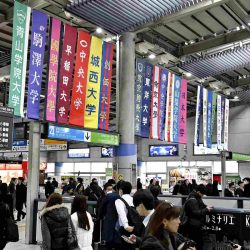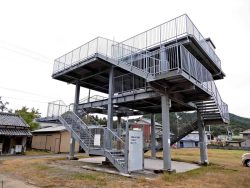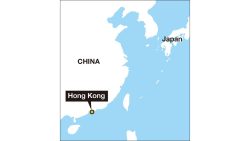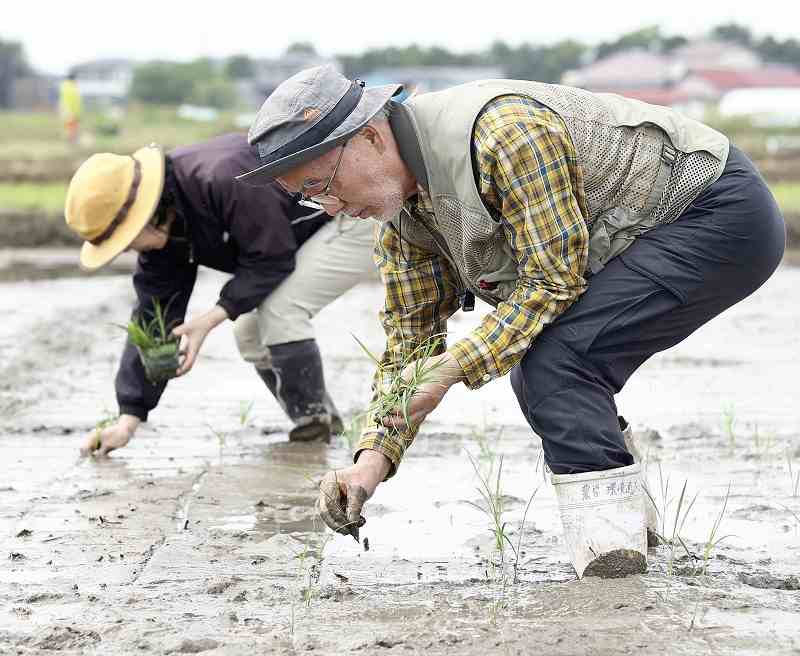
Tadashi Sato, right, of Tohoku University plants rice seedlings as part of an experiment in Osaki, Miyagi Prefecture, on May 23.
6:00 JST, June 21, 2022
A Japanese research group has developed a rice strain with a higher yield than existing varieties, even when grown in saline soil.
The researchers from Tohoku University in Sendai and the National Agriculture and Food Research Organization (NARO) in Tsukuba, Ibaraki Prefecture began developing salt-resistant rice plants in Miyagi Prefecture, where farmland was damaged by sea water following the Great East Japan Earthquake and tsunami in 2011.
Soil damage has almost been eliminated in the prefecture since, so the researchers are now considering promoting their new technology in overseas areas that suffer salt damage, such as Southeast Asia and elsewhere.
In late May, students and local farmers planted rice seedlings in Tohoku University’s experimental rice paddies in Osaki, Miyagi Prefecture. They planted two types of Indica rice, which is widely grown in Southeast Asia and Africa — a standard strain and a salty soil-tolerant strain developed by the group. Similar numbers of seedlings were planted, and the yield and quality of the two types were later examined and compared.
The researchers found that the roots of the “improved” Indica rice plants “sat” on top of the soil as opposed to extending into the ground, as was the case with the standard type. Salt makes soil more clay-like, which reduces oxygen levels and makes it difficult for plant roots to absorb water, thereby affecting growth.
If the roots grow on top of the soil, however, then the rice is less prone to be affected by the soil’s condition.
Incorporating the gene to encourage roots to grow on top of the soil was key in developing the new strain. The gene derives from an Indonesian rice type. By utilizing this gene in a different rice variety through cross-fertilization, it becomes possible to change the way roots grow.
“I’m looking forward to the autumn harvest and witnessing the power of a rice developed after the quake,” said 73-year-old Tadashi Sato, a Tohoku University researcher who has been played a central role in the study.
2 years of reconstruction
The 2011 tsunami flooded 21,480 hectares of coastal farmland, stretching from the Tohoku region to the Kanto region, badly damaging the soil due to the water’s salt content. The area included 10% of Miyagi Prefecture’s arable land.
Sato was an associate professor at the university around that time and he recalls seeing fish swimming in paddies along the prefectural coast after the quake. He was subsequently inundated with questions relating to flooded farmland, such as how to mitigate the damage and how long it would take to do so.
When salt damages rice paddies, holes must be dug to improve drainage. The holes are then repeatedly flushed with clean water to eliminate the salt. These steps took two years to complete in the prefecture. Some farmers in the affected areas decided to stop farming altogether and use their land for other purposes.
“To prevent a decrease in farming households, we need to find ways to resume quickly growing crops,” Sato recalled thinking.
Thanks to his studies, Sato knew that some rice breeds in Southeast Asia and other locations have different root systems than those usually found in Japan. He posited that changing the way roots grow could make a rice strain less susceptible to salt damage. After discussing the idea with Yusaku Uga, 47, of NARO, they repeatedly crossed an Indonesian strain with the Sasanishiki Japanese rice type to isolate the desired gene that encourages roots to grow across — rather than deeply into — the ground.
In 2014, they trialed the new Sasanishiki rice. As a result, they found that seedlings with the gene produced a 15% higher yield than non-altered seedlings when planted in saline soil.
Salt damage along Mekong River
According to the Agriculture, Forestry and Fishery Ministry, 95% of the farmland damaged by the 2011 quake has been restored, except for areas converted into residential land. This land is once again cultivatable, apart from fields on the Fukushima Prefecture coast in areas where residents are not allowed to return.
As the soil has generally recovered, the research group is now looking overseas to make the most of their new idea.
Salt damage often occurs in rice paddies in coastal parts of Vietnam, Myanmar, Indonesia and Bangladesh. In Vietnam, for example, a decrease in the Mekong River’s flow during the dry season caused sea water to flow upstream from the river’s mouth. As a result, 1.8 million hectares of rice-growing land faces possible salt damage.
Chronic salt damage makes it difficult to “repair” soil as in Miyagi Prefecture. It is, however, possible to reduce the impact of damage by adopting genetically altered strains of rice.
The research group is now considering collaborating with overseas researchers to speed adoption of the new salt-resistant gene in local rice strains.
“I’d be happy if we could contribute to the world’s future by using our technology, which was developed as a result of the difficulties farmers faced after the quake,” Sato said.
"Society" POPULAR ARTICLE
-

M4.9 Earthquake Hits Tokyo, Neighboring Prefectures
-

Israeli Tourists Refused Accommodation at Hotel in Japan’s Nagano Pref., Prompting Protest by Israeli Embassy and Probe by Prefecture
-

M7.5 Earthquake Hits Northern Japan; Tsunami Waves Observed in Hokkaido, Aomori and Iwate Prefectures
-

Tsukiji Market Urges Tourists to Avoid Visiting in Year-End
-
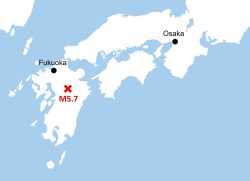
M5.7 Earthquake Hits Japan’s Kumamoto Pref., Measuring Upper 5 Intensity, No Tsunami Expected
JN ACCESS RANKING
-

Tokyo Economic Security Forum to Hold Inaugural Meeting Amid Tense Global Environment
-

Keidanren Chairman Yoshinobu Tsutsui Visits Kashiwazaki-Kariwa Nuclear Power Plant; Inspects New Emergency Safety System
-

Imports of Rare Earths from China Facing Delays, May Be Caused by Deterioration of Japan-China Relations
-

University of Tokyo Professor Discusses Japanese Economic Security in Interview Ahead of Forum
-

Japan Pulls out of Vietnam Nuclear Project, Complicating Hanoi’s Power Plans


